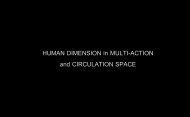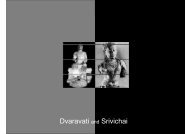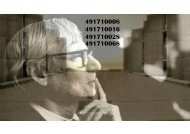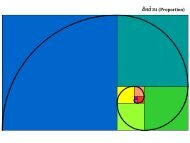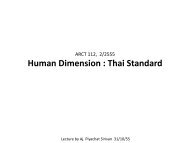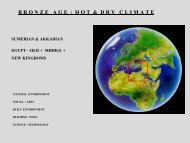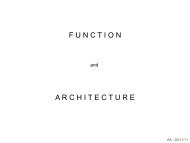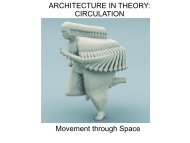IDENTITY INTIMACY AND DOMICILE Notes on the phenomenology of home
Notes on the phenomenology of home - Faculty of Architecture ...
Notes on the phenomenology of home - Faculty of Architecture ...
Create successful ePaper yourself
Turn your PDF publications into a flip-book with our unique Google optimized e-Paper software.
JUHANI PALLASMAA: <str<strong>on</strong>g>IDENTITY</str<strong>on</strong>g>, <str<strong>on</strong>g>INTIMACY</str<strong>on</strong>g> <str<strong>on</strong>g>AND</str<strong>on</strong>g> <str<strong>on</strong>g>DOMICILE</str<strong>on</strong>g> - <str<strong>on</strong>g>Notes</str<strong>on</strong>g> <strong>on</strong> <strong>the</strong> <strong>phenomenology</strong> <strong>of</strong> <strong>home</strong><strong>the</strong> wall <strong>of</strong> its neighbouring building. These traces <strong>of</strong> life enabled Brigge torecreate his own past. Rilke describes with staggering force how lifepenetrates dead matter; <strong>the</strong> history <strong>of</strong> life can he traced in <strong>the</strong> minutestfragment <strong>of</strong> <strong>the</strong> dwelling."But <strong>the</strong> walls <strong>the</strong>mselves were <strong>the</strong> most unforgettable. The stubborn life<strong>of</strong> <strong>the</strong>se rooms had not allowed itself to be trampled out. It was still <strong>the</strong>re;it clung to <strong>the</strong> nails that had been left in <strong>the</strong> walls; it found a resting-place<strong>on</strong> <strong>the</strong> remaining handbreadth <strong>of</strong> flooring; it squatted beneath <strong>the</strong> cornerbeams where a little bit <strong>of</strong> space remained. One could see it in <strong>the</strong> colourswhich it had slowly changed, year by year: blue into a mouldy green,green into grey, and yellow into a stale, drab, weary white. But it was alsoin <strong>the</strong> places that had kept fresher, behind <strong>the</strong> mirrors, <strong>the</strong> pictures, and<strong>the</strong> wardrobes; for it bad outlined <strong>the</strong>ir c<strong>on</strong>tours over and over again, andhad been with cobwebs and dust even in <strong>the</strong>se hidden retreats that nowlay uncovered. It was in every bare, flayed streak <strong>of</strong> surface, it was in <strong>the</strong>blisters <strong>the</strong> dampness had raised at <strong>the</strong> edges <strong>of</strong> <strong>the</strong> wallpapers; it floatedin <strong>the</strong> torn-<strong>of</strong>f shreds, and sweated out <strong>of</strong> <strong>the</strong> l<strong>on</strong>g-standing spots <strong>of</strong> filth.And from <strong>the</strong>se walls <strong>on</strong>ce blue, and green and yellow, framed by <strong>the</strong>tracks <strong>of</strong> <strong>the</strong> disturbed partiti<strong>on</strong>s, <strong>the</strong> breath <strong>of</strong> <strong>the</strong>se lives came forth -<strong>the</strong> clammy, stuggish, fusty breath, which no wind had yet scattered.There were <strong>the</strong> midday meals and <strong>the</strong> sicknesses and <strong>the</strong> exhalati<strong>on</strong>s and<strong>the</strong> smoke <strong>of</strong> years, and <strong>the</strong> stale breath <strong>of</strong> mouths, and <strong>the</strong> oily odour <strong>of</strong>perspiring feet. There were <strong>the</strong> pungent tang <strong>of</strong> urine and <strong>the</strong> stench <strong>of</strong>burning soot and <strong>the</strong> grey reek <strong>on</strong> potatoes, and <strong>the</strong> heavy, sickly fumes<strong>of</strong> rancid grease. The sweetish, lingering smell <strong>of</strong> neglected infants was<strong>the</strong>re, and <strong>the</strong> smell <strong>of</strong> frightened children who go to school, and <strong>the</strong>stuffiness <strong>of</strong> <strong>the</strong> beds <strong>of</strong> nubile youths. 13I apologize for <strong>the</strong> lengthy quote, but I wanted to point out how lifepenetrates verbal images <strong>of</strong> a great poem as compared to <strong>the</strong> sterilizedimages <strong>of</strong> c<strong>on</strong>temporary architecture.In its emoti<strong>on</strong>al power, Rilke's descripti<strong>on</strong> reminds <strong>on</strong>e <strong>of</strong> Heidegger'sfamous descripti<strong>on</strong> <strong>of</strong> <strong>the</strong> epic message <strong>of</strong> van Gogh's Peasant's shoes. 14The later questi<strong>on</strong>ing <strong>of</strong> <strong>the</strong> relevance <strong>of</strong> Heidegger's interpretati<strong>on</strong> byMeyer Shapiro does not diminish <strong>the</strong> poetic power <strong>of</strong> his descripti<strong>on</strong>: hehas pointed out ihat van Gogh actually painted his own shoes and,besides, he did <strong>the</strong> painting during his short stay in Paris. What isimportant, however, is <strong>the</strong> artist's extraordinary dense imagery thatreflects an au<strong>the</strong>ntic form <strong>of</strong> life.In <strong>the</strong> intimate polarity, Bachelard points out a bodily experience <strong>of</strong> <strong>the</strong><strong>home</strong>: 'Indeed, in our houses we have nooks and corners in which we liketo curl up comfortably. To curl up bel<strong>on</strong>gs to <strong>the</strong> <strong>phenomenology</strong> <strong>of</strong> <strong>the</strong>http://www2.uiah.fi/esittely/historia/e_ident.htm (11 <strong>of</strong> 23)22/10/2550 16:34:02



